by Diane Pleschner | Dec 7, 2023 | Recipes, WF News
According to Wikipedia, Pancetta is salt-cured pork belly meat.
In Italy, it is often used to add depth to soups and pastas. Foodies worldwide value Pancetta’s flavor profile. Two basic types of pancetta are arrotolata (rolled) and stesa (flat).
For cooking, pancetta stesa may be cut into cubes for use in carbonara pasta or pizza, as is typically found in central and southern Italy. In northern Italy, pancetta arrotolata is commonly served rolled and thinly sliced, and consumed raw (although guanciale, cured jowl meat, is generally considered more traditional).
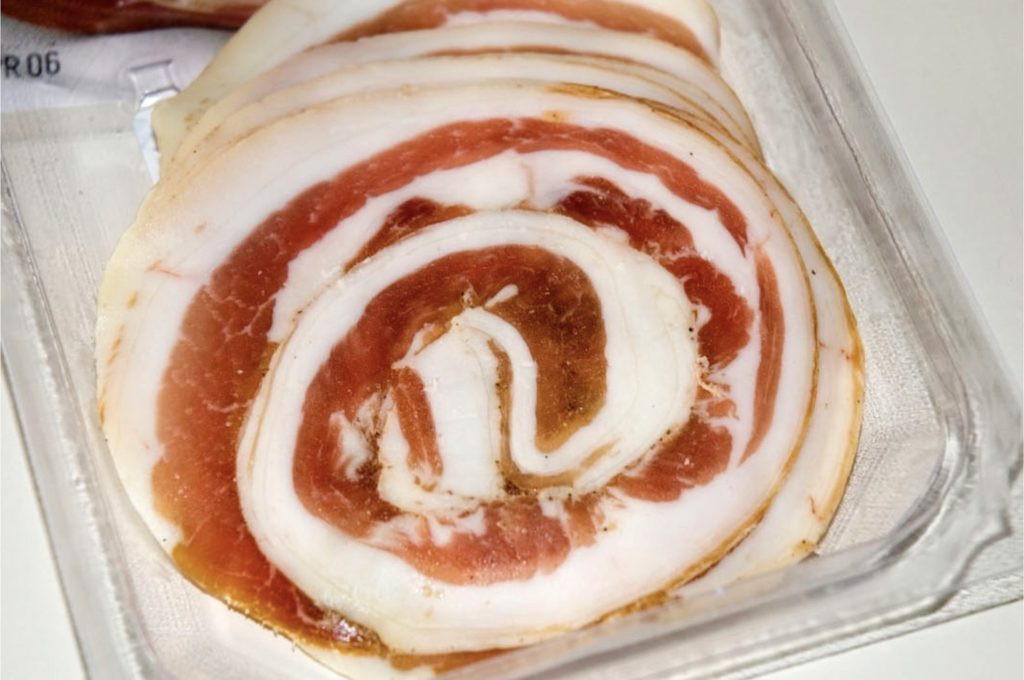 Photo credit: Nachoman-au – CC BY-SA 3.0, https://commons.wikimedia.org/w/index.php?curid=522168
Photo credit: Nachoman-au – CC BY-SA 3.0, https://commons.wikimedia.org/w/index.php?curid=522168
The art of pancetta, as with all salume products, is in the curing process. Here at Winfield Farm, we are pleased to offer an exclusive treat: Mangalitsa pork pancetta cured by Alle Pia Fine Cured Meats.
Following their family tradition, and inspected by USDA, Alle Pia first marinates the Mangalitsa bellies in vacuum-sealed bags for three weeks, to infuse special seasonings, including rosemary, garlic, juniper berry and sea salt. As part of the curing process, the bellies are then removed from the bags and hung in a temperature-controlled chamber for 30 days.
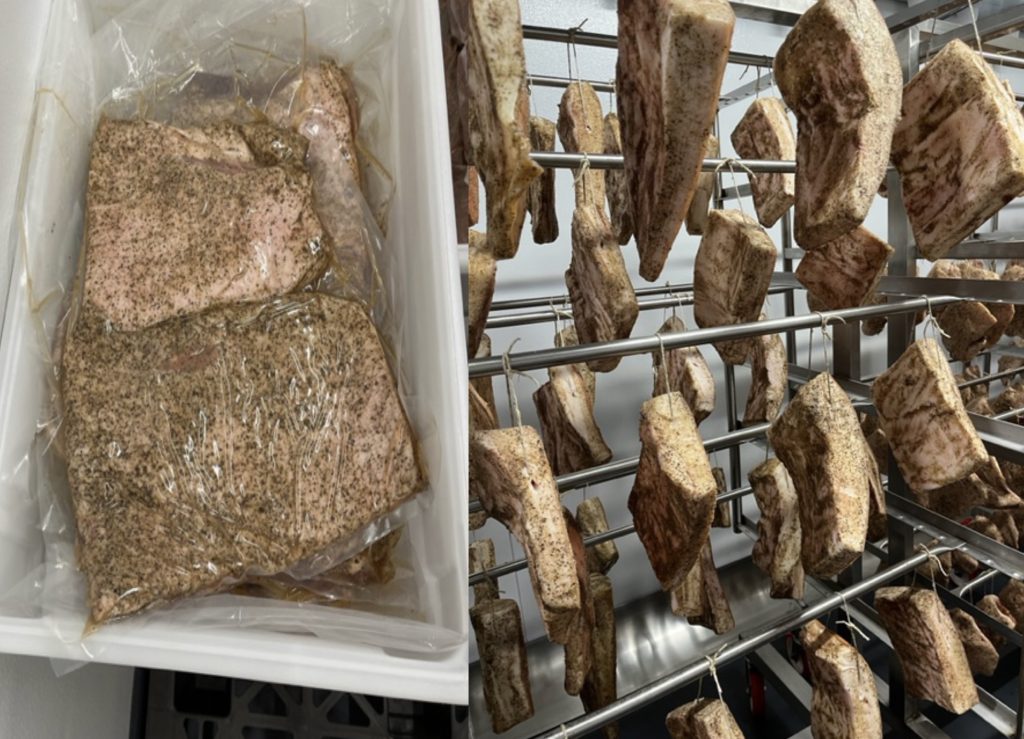
You can taste Mangalitsa magic by special ordering Mangalitsa pancetta (stesa). Email us directly at Winfield Farm (dplesch@gmail.com). Supply is limited (not listed on our online Mangalitsa Market).
$35 / lb Pieces average approx. 4-5 pounds each
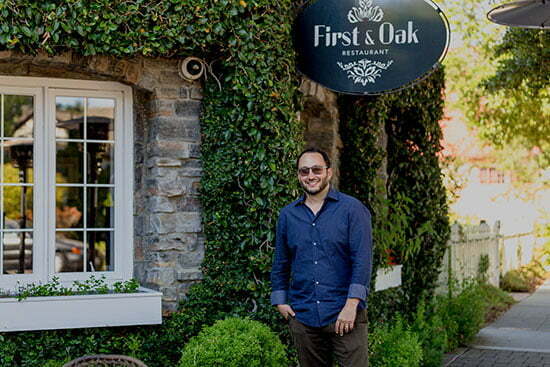
by Diane Pleschner | Feb 22, 2023 | WF News
We are thrilled to be serving a new restaurant!
Sourcing sustainable meat and seafood is at the heart & soul of what they do at First and Oak, located inside the Mirabelle Inn, in the heart of Solvang, California. Proud recipients of a Michelin Plate designation, they offer a seasonal menu that highlights local & organic ingredients prepared in a thoughtful manner. Their finely curated courses are all about transcending flavors, featuring unique surprises such as our Mangalitsa loin chops.
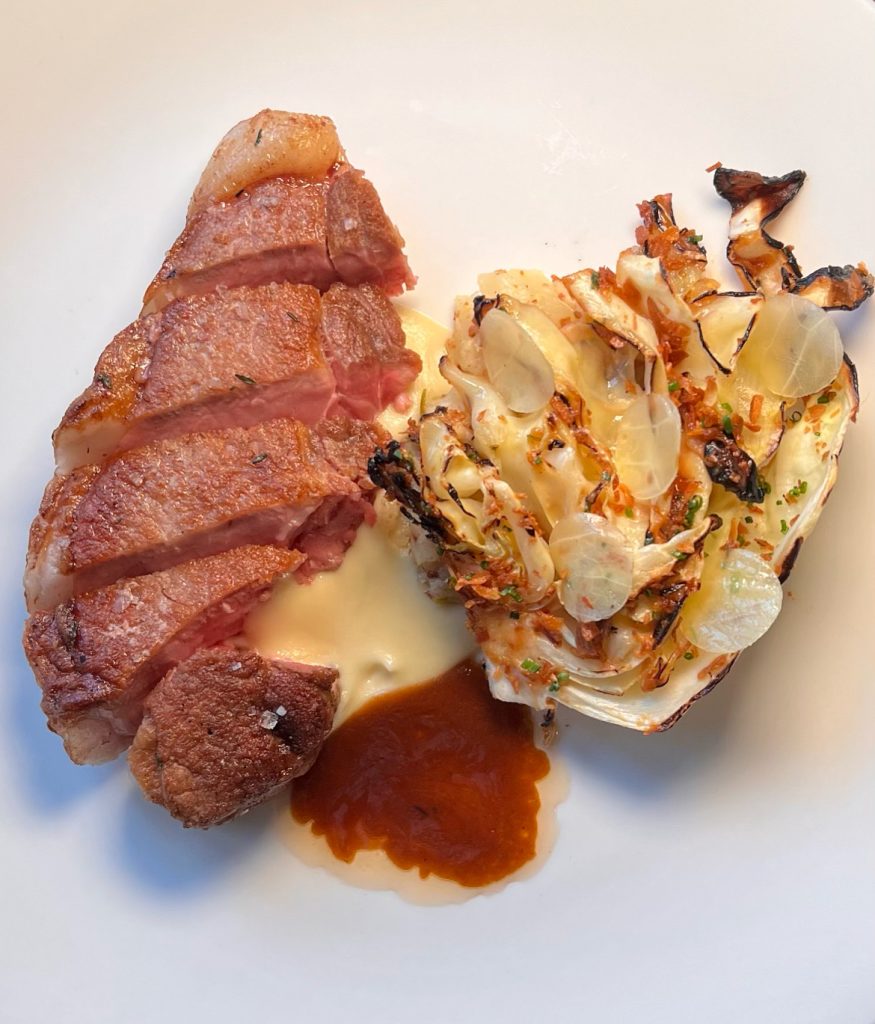
Mangalitsa Loin Chop
They love to highlight small farms like us that share the same passion. Here’s what they say about Winfield Farm:
by Bruce Steele | Jul 13, 2015 | Uncategorized
— Republished from Edible Santa Barbara 2015 Summer Edition —
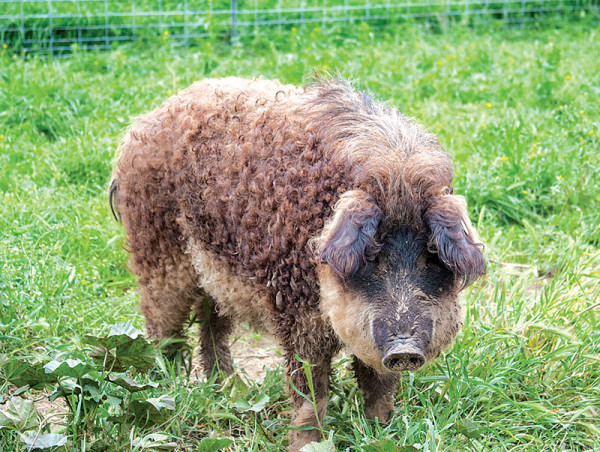
The Mangalitsa pig is a special breed known for its thick fat, but is also identified easily by its unique curly and wooly coat. Photo by Rosminah Brown.
Heritage Serendipity
Winfield Farm is run by Bruce and Diane Steele. Bruce had a longtime dream to have a pig that would help consume surplus produce on his farm. What ended up happening was an explosion of pigs that’s resetting the course of the farm’s operations and helping bring a heritage breed back into popularity that was once on a path of dying out.
Bruce started out as an urchin diver and fisherman, and in 2003 became a land farmer in Buellton on Highway 246 about three miles west of Highway 101. Winfield Farm is most easily spotted by his pale blue fishing boat parked at the base of the driveway. The farm had been in land production for 10 years before Bruce’s dream of having a pig first became a reality.
The Steeles specialize in just one heritage breed, the Mangalitsa, also called a Wooly Pig, and also known as a Lard Hog. The Mangalitsa stock hails from 19th century Eastern Europe. The Mangalitsa has exceptional fat and was the prize pork of Austro-Hungarian nobility at the turn of the century. Once you see how much fat is on its body, it’s a wonder this tenacious breed can move about quickly and easily at all.
The breed is considered rare, and it almost died out entirely. Because the Mangalitsa has so much lard, the breed was unpopular in the 1970s and ’80s when fat became unfashionable. Who remembers the ad campaign for “the other white meat?” It was almost extinction for the Mangalitsa. But thanks to the growing popularity of bacon and pork in general, a desire for rich flavor and unctuous texture in meat, and the recognition that genetic diversity is a good thing, the Mangalitsa is making a comeback and its smooth silky fat is now held in glorious esteem. Winfield Farm is currently the largest breeder of the Mangalitsa in Southern California.
The pigs are fed with fruit and vegetables from the farm with additional organic grain supplement. If Bruce sees an opportunity to feed them something local and readily available, he’ll give it to them. Like autumn acorns or winter squash. So much squash.
The Mangalitsa pigs seem to breed like crazy and the Steeles are excitedly incredulous at times that their initial investment in 2013 of a handful of pigs has become an increasing series of enclosures with their original pigs, then a serendipitous rescue of 13 additional Mangalitsas, plus their next generations. Now there’s new sets of spunky piglets that arrived over Christmastime, running around, squealing, rooting and foraging. They grow so quickly.
Bruce is often constructing new shelters for expectant sows to birth and nurse their young. It’s not all a fairy tale—the reality is that stillborns occur, and when some don’t make it due to a sudden cold snap or the lack of enough suckling teats to go around, it is upsetting to everyone. This is farm life and it comes with unanticipated death as well. As for their fondness of the Mangalitsa piglets, Bruce says with both a smile and a shake of his head, “they’re just so darned cute.”
Winfield Farm to Chef – Full of Life Flatbread
Winfield supplies whole pigs by order to local restaurants, such as Full of Life Flatbread in Los Alamos. Chef/owner Clark Staub purchased a whole Mangalitsa last summer, and he and his staff broke it down and processed it entirely. The specials menu ran fresh Mangalitsa dishes for several weeks, while its legs were set to cure for longer-term projects, like smoked hams, speck and lardo that started to grace dinner plates this past February.
Sourcing locally is important to Full of Life, and the relationship between farmer and chef in this case is especially close—Clark lives just a few miles away from Winfield Farm off Highway 246 and passes it daily on his way to the restaurant. Not only do we have the opportunity to eat this spectacular pork prepared by one of our county’s favorite chefs, but the two are collaborating on recipes for an upcoming Mangalitsa cookbook. Something to watch out for!
Resources
Direct purchase is available to the public, by ordering online or purchasing pork through the farm’s weekend produce stand. Winfield offers the magic of Mangalitsa in all varieties of cuts and processing. The primals, or basic large cuts, are the biggest and least expensive per pound, while packets of bacon, chops or sausages are available by the pound, which is a very approachable option for those making a first foray into local heritage pork. They are a great source for the Mangalitsa’s special feature: its fat. Both leaf fat and back fat can be bought, useful for making flaky pastry or cut into lean-meat sausages, respectively.
Slaughter and processing takes place farther north. Currently this requires driving the pigs to a USDA-certified slaughterhouse in Fresno; the Steeles hope to bring this closer to home when such an option becomes available. In Bruce’s ideal world, he would like to convert all this farming equipment to solar—even the tillers and plows.
Whole pig prices are $7 per pound, and are custom scheduled by contacting Winfield Farm. Select cuts in smaller portions range from $10 to $15 per pound. These can be bought by mail order, shipped or picked up in person at their weekend farm stand in Buellton.
Read the original post: Edible Santa Barbara
by Bruce Steele | May 29, 2015 | Mangalitsa Pigs
By Francesca Shanks on May 1, 2015
This book is a love letter to a unique Hungarian pig breed, a breed whose history seems miraculous when compared to America’s agricultural traditions.

The curly-haired Mangalitsa’s “genetics have remained untouched since 1833”—an almost unbelievable story for those acquainted with large-scale agriculture in the U.S. But raising these pigs is a long game—they aren’t bred to fatten up quickly. They’re renowned for their taste and the quality of their lard, and they’ve found their way to several of the country’s highest-rated restaurants in recent years.
But, according to the book’s authors, this almost wasn’t so: in the early 1990s, less than 200 Mangalitsa pigs remained, prompting Peter Toth and a partner to buy a herd of 50 from a Hungarian farmer in order to expand the Mangalitsa’s numbers. Today, Toth is president of the Hungarian National Association of Mangalitsa Breeders, and, he writes, the breed is 10,000 strong.
TheMangalitsa_recipes-1Mangalitsa pigs are now (again) a big part of Hungarian cuisine, as 23 Hungarian chefs demonstrate with recipes that incorporate Mangalitsa cuts, from lard to brain to loin. Each beautifully photographed recipe comes with a short chef profile and detailed instructions—make Zsolt Litauszki’s Mangalitsa rillette in breadcrumbs with fermented wax beans, or simply marvel at Antonio Fekete’s “Apple dessert,” a white chocolate-covered molded apple mousse complete with dark chocolate stem (no pig included in this recipe).
If you’re desperate to taste Mangalitsa for yourself, there’s a list, including a map, of Hungarian restaurants at the back of the book, plus a couple of pages advertising Mangalitsa farmers in the U.S.
This beautiful book, with gold-embossed title and incredible photography, is translated from Hungarian, which, unfortunately, results in some typographical errors. This may drive you crazy if you’re an editor type, but don’t let it get in the way of the opportunity to read about this fascinating pig breed. If you are interested in a story that merges fine cuisine with a passion for animal husbandry, you’ll enjoy The Mangalitsa Pig, and probably learn something, too.
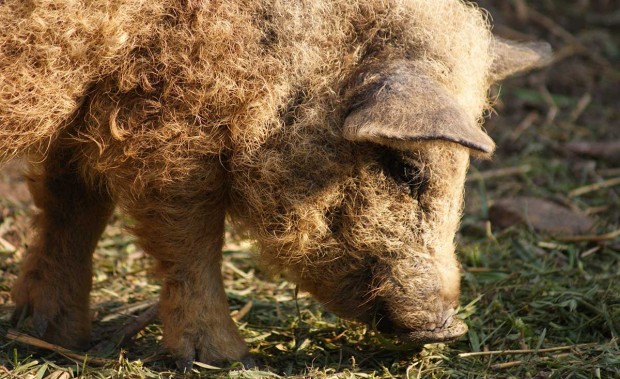
The Mangalitsa Pig: Royalty is Coming to America
by Mate Dobesch, Wilhelm W. Kohl, Peter Toth, Beata Bencsics, Eszter Szalai (Translator)
247 pages; Boook Publishing Hungary, 2014
Read the original post: modernfarmer.com
by Bruce Steele | Jan 22, 2015 | Mangalitsa Pigs
Winfield Farm Mangalitsas are raised naturally on pasture, and are fed barley and organically grown pumpkins and squash, much of it grown right here. All pigs going to market are finished on acorns, walnuts, and almonds when available – their diet like the famed Iberico pigs that are cured for premium prosciutto – pata negra.
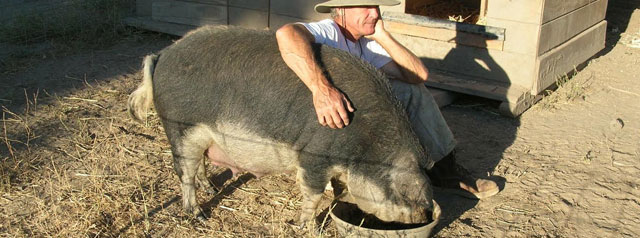
 Photo credit: Nachoman-au – CC BY-SA 3.0, https://commons.wikimedia.org/w/index.php?curid=522168
Photo credit: Nachoman-au – CC BY-SA 3.0, https://commons.wikimedia.org/w/index.php?curid=522168






